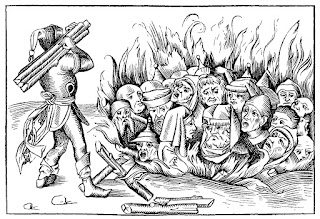Cologne and the Black Death, 1349
23 August, 1349
Cologne
With the Black Death spreading across Europe, Jewish communities were scapegoated and attacked, starting in 1348. Over 500 Jewish communities were annihilated during this period.
The city council of Cologne saw how the Jewish community in Strasbourg had been trapped in the Jewish cemetery and burned to death. At first they made efforts to protect their Jewish community. When it became clear that the people of Cologne were going to attack the Jews regardless of what the city elders did, the town council switched gears and planned how to use a massacre in Cologne to their benefit.
On St. Bartholomew's Night in 1349, the Jewish quarter of Cologne was attacked. Many Jews fled to the synagogue where, determined to die as martyrs, they themselves set fire the synagogue and perished in the flames. All the Jews of the community were killed. The authorities in Cologne mostly concerned themselves with how to fairly divide the property of the dead Jews. (Norman Roth, Medieval Jewish Civilization, 178)
Remains of the synagogue have been excavated by German archaeologists, revealing artifacts from the building and evidence of the fire.
A Franciscan friar, Herman Gigas, wrote in 1349 that
Cologne
With the Black Death spreading across Europe, Jewish communities were scapegoated and attacked, starting in 1348. Over 500 Jewish communities were annihilated during this period.
The city council of Cologne saw how the Jewish community in Strasbourg had been trapped in the Jewish cemetery and burned to death. At first they made efforts to protect their Jewish community. When it became clear that the people of Cologne were going to attack the Jews regardless of what the city elders did, the town council switched gears and planned how to use a massacre in Cologne to their benefit.
On St. Bartholomew's Night in 1349, the Jewish quarter of Cologne was attacked. Many Jews fled to the synagogue where, determined to die as martyrs, they themselves set fire the synagogue and perished in the flames. All the Jews of the community were killed. The authorities in Cologne mostly concerned themselves with how to fairly divide the property of the dead Jews. (Norman Roth, Medieval Jewish Civilization, 178)
Remains of the synagogue have been excavated by German archaeologists, revealing artifacts from the building and evidence of the fire.
A Franciscan friar, Herman Gigas, wrote in 1349 that
"God, the lord of vengeance, has not suffered the malice of the Jews to go unpunished. Throughout Germany, in all but a few places, they were burnt...it still continues unabated, for in a number of regions many people, noble and humble alike, have laid plans against them and their defenders which they will never abandon until the whole Jewish race has been destroyed." (In Rosemay Horrox, The Black Death, 207)


Comments
Post a Comment